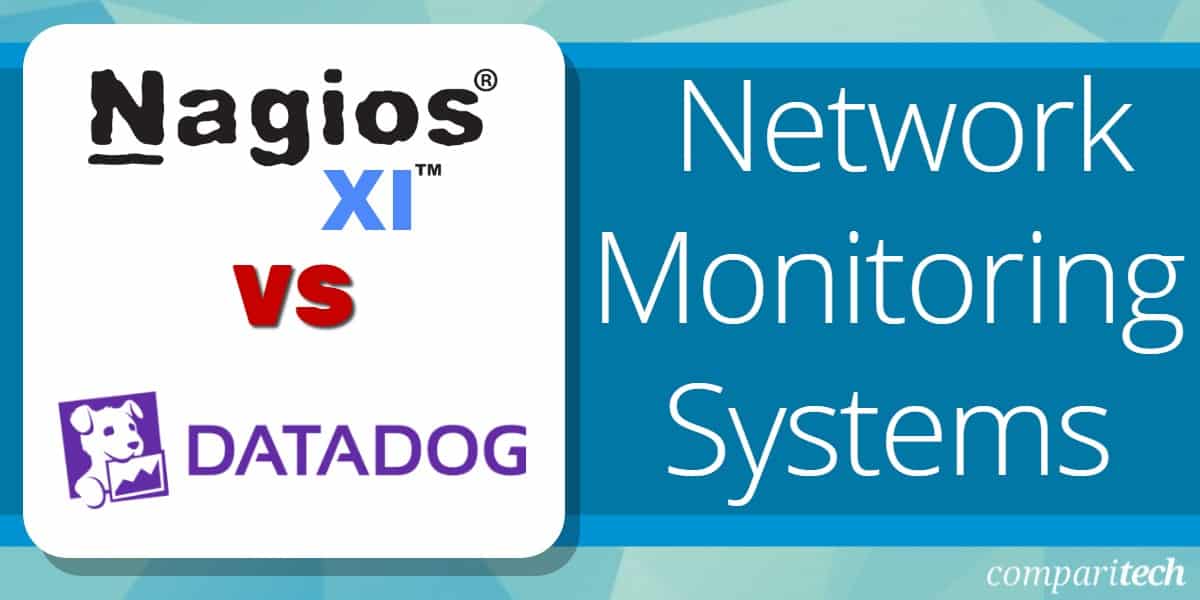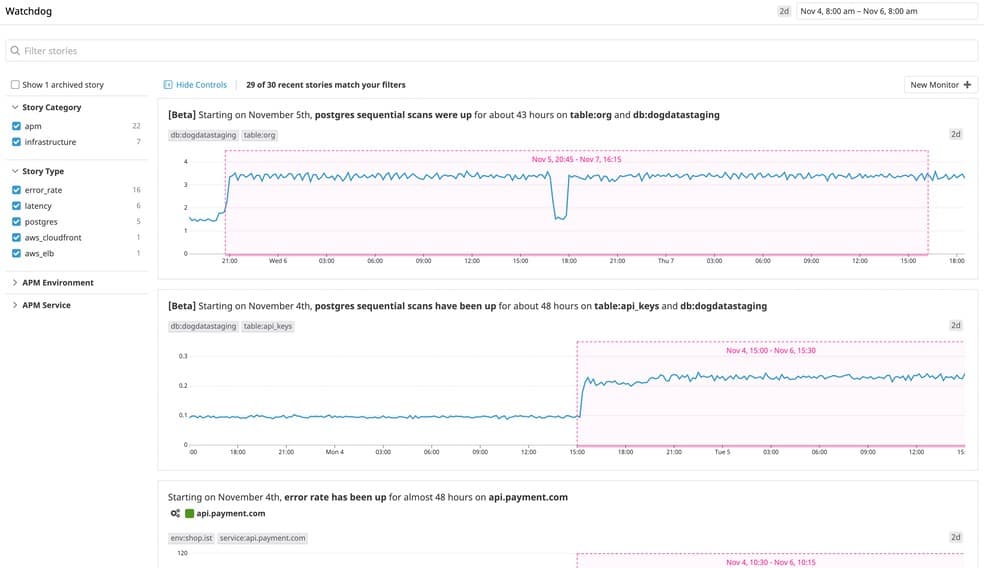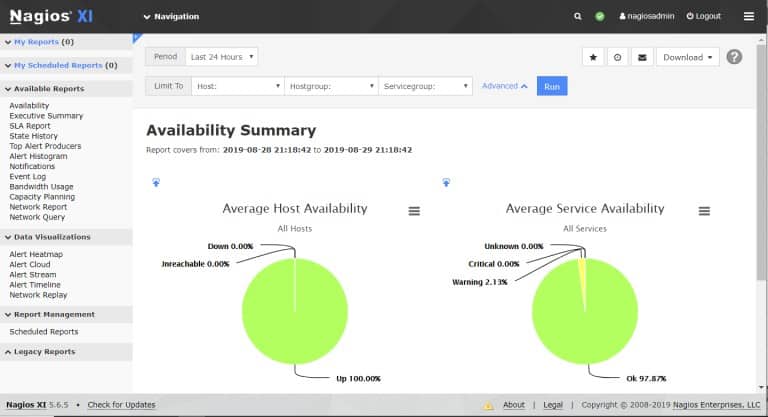Nagios is a powerful solution that can meet the needs of any organization, from SMB to large enterprises. Datadog’s SaaS-based model makes it ideal for organizations that don’t want to burden themselves with any resource-intensive on-premise monitoring solution. In this post, we compare these two tools and review their features so you can make the right choice for your organization.
Overview of Nagios XI
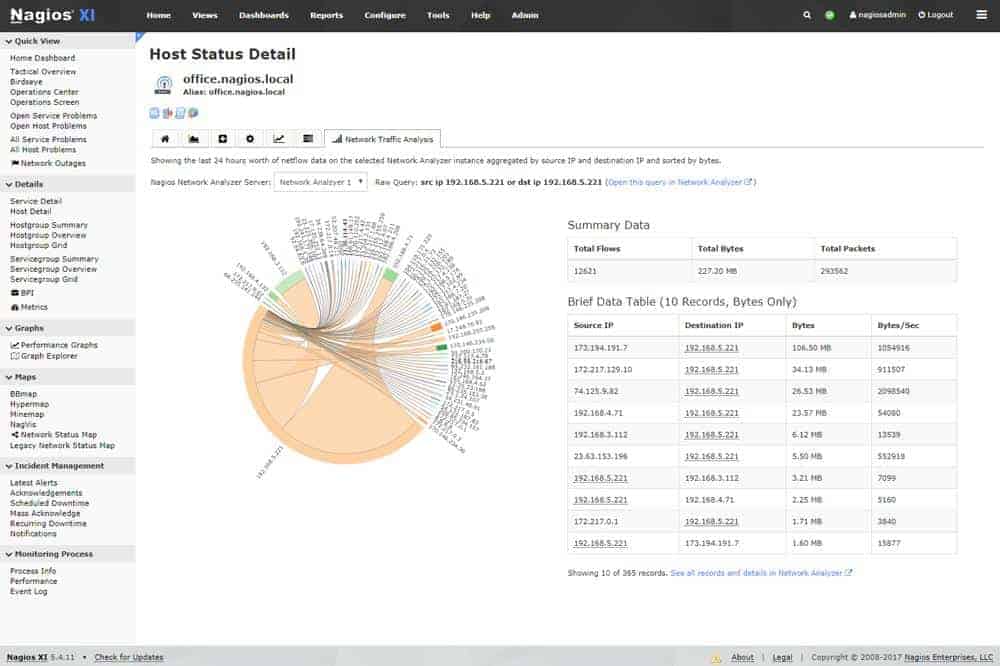
Nagios is a U.S-based company that delivers IT infrastructure monitoring and management software that enables organizations to identify and resolve problems before it gets out of hand. The product comes in two editions—Nagios Core and Nagios XI.
Key Features:
- Comprehensive Monitoring: Monitors all critical infrastructure components to ensure smooth operations.
- Problem Remediation: Automatically addresses and fixes failed network components, applications, and services.
- Proactive Planning: Facilitates proactive planning for system upgrades and enhancements.
- Multi-Tenant Capabilities: Allows multiple users to access with user-specific views.
- Extendable Architecture: Integrates seamlessly with third-party applications via APIs and add-ons.
- Awareness: Delivers timely alerts to IT staff through email and SMS notifications.
- Visibility: Provides comprehensive visibility into all IT operations.
- Reporting: Generates up-to-date availability and historical reports.
Nagios Core is an agent-based free and open-source infrastructure monitoring application. On the other hand, Nagios XI is an easy-to-use agentless commercial edition that uses Nagios Core as its back-end alongside other technologies, including a built-in web configuration GUI, making it much easier to manage than Nagios Core. In addition, Nagios XI is available in Standard and Enterprise editions. The Enterprise Edition provides you with features designed to aid in large-scale configuration, forecasting, and scheduled reporting.
Nagios XI monitors critical IT infrastructure components such as network devices, servers, applications, including network protocols and system metrics and resources. Some of the essential protocols of network and system resources monitored include:
- Network protocols include SMTP, POP3, HTTP, NNTP, ICMP, SNMP, FTP, SSH, and many more.
- Host resources such as processor load, disk usage, system logs, and more, using monitoring agents.
- Hardware conditions such as temperature, alarms, and more
It alerts administrators when those critical components fail and when they recover after the problem has been resolved. It runs mainly on Linux operating systems.
Pros:
- Informative Interface: The interface is simple yet provides detailed information.
- Flexible Alerting: Supports a variety of alerting options, including SMS and email.
- Community Plugins: A wide range of community-designed plugins are available at no cost.
Cons:
- Limited Support for Open-Source Version: The open-source version does not include the support found in the paid versions.
Overview of Datadog
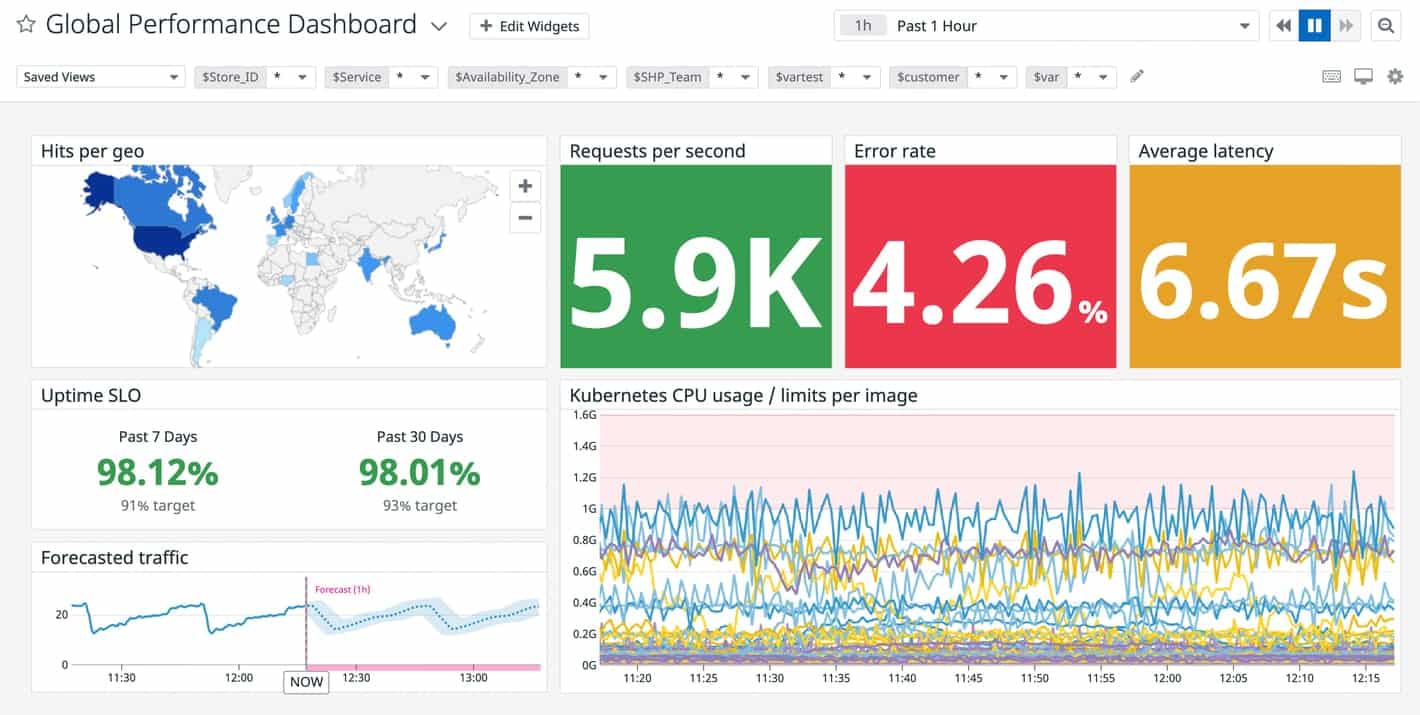
Datadog is an agent-based on-prem and cloud infrastructure monitoring service for cloud applications, servers, databases, tools, and services. It’s headquartered in New York and has Boston, Dublin, Paris, Singapore, Sydney, essential network protocols, and Tokyo. Datadog was named a Leader in the 2021 Gartner Magic Quadrant for Application Performance Monitoring. It provides developers and IT operations teams real-time visibility into all technology infrastructure through a single visual interface. Datadog uses its auto-discovery service to explore and identify devices in your network. The outcome of the auto-discovery service is then used to create a device inventory, which forms an index for the complete monitoring service.
Key Features:
- Network Monitoring: Visualizes traffic flow in cloud-native environments with easy-to-understand tags.
- Application Performance Management: Monitors, troubleshoots, and optimizes the performance of applications.
- Log Management: Provides quick search, filter, and analysis of logs for troubleshooting.
- Synthetics: Proactively monitors end-to-end user experience with an intuitive web recorder.
- Custom Alerts: Enables the creation of alerts for any metric or performance issue, with notifications via email, PagerDuty, Slack, etc.
- Integrations: Integrates with multiple products and development stacks to aggregate metrics and events.
- Interactive Dashboards: High-resolution dashboards monitor and graph real-time metrics and events.
- Collaboration Tools: Enhances visibility across teams with annotations, recorded problems, and in-context communication.
- API Access: Allows capturing events and metrics using client libraries for observing apps and infrastructure.
Once all devices and links have been identified, you can overview all network activity from the Datadog dashboard. The service also draws up a network topology map that can be used to get quick insights into each node. Any changes to the network can be automatically spotted. This helps to adjust the network inventory and topology map without any human intervention. Traffic flow analysis features in the Datadog tool enable you to examine each device and link to discover total capacity and utilization. The analysis features let you see which applications or endpoints generate the most traffic on your network.
Pros:
- Numerous Monitoring Templates: Offers a variety of user monitors through templates and widgets.
- Holistic View: Monitors both internally and externally, providing a comprehensive view of network performance.
- Real-Time Updates: Reflects changes to the network in near real-time.
- Scalable Monitoring: Allows businesses to scale their monitoring efforts reliably with flexible pricing options.
Cons:
- Short Trial Period: A longer trial period for testing would be beneficial.
A free 14-day-trial with full access to all the features is available for download. After that, the software is generally sold through monthly subscription plans based on hosts, events, or logs.
Nagios XI Vs Datadog: How they Compare
Systems Requirements and Installation
Nagios XI runs on Linux OS with very minimal resource requirements. Because Nagios XI is agentless, the installation process is pretty much straightforward. The fastest way to get up and running is to use the Nagios XI VMware virtual machine. This can also be used in enterprise environments where VMware ESX, vSphere, or other VMware server products are deployed. You can also install Nagios XI manually on a physical server. Once it’s up and running, you can start adding devices for monitoring. This contrasts to Datadog, which requires device-by-device agent installation followed by the tool’s initial setup process.
Nagios XI provides a wizard for nearly every common application stack you might need. In addition, its auto-discovery mechanism helps you discover devices to be monitored and allows you to choose the services you want to be observed on each discovered device.
Since Datadog is a SaaS-based application, there are no on-premise system requirements and no installation hassles. However, you’ll be required to install local agents specific to the device or service you wish to monitor for the most part. An agent-based mode means no auto-discovery feature, so you have to deploy an agent for all your devices individually. Datadog supports integration with VMware vSphere, but the setup process is a bit complicated. That said, Datagod provides enough documentation and setup instructions to guide you through the installation and configuration process.
Dashboards and Visualizations
Nagios XI dashboards are designed to provide individual users with customized information they find helpful. Each user can create their own unique set of dashboards to customize Nagios XI to fit their needs. The interface is not particularly fun to look at when compared to more modern-looking interfaces. But if you look beyond that, you’ll see it’s well organized. Nagios XI allows administrators to deploy dashboards to other Nagios XI users. However, there is no provision to manage every user’s dashboards on one screen centrally. You can only manage dashboards for the user that you are currently logged in as.
Datadog is aesthetically pleasing from a visual perspective with its clean and modern dashboard design. In addition, Datadog allows you to customize your dashboards with a vast library of visualization tools and drag-and-drop widgets. But it requires a lot of setup work to get things working. Once set up, there are two primary ways of visualizing your data:
Screenboards These are grid-based dashboards with free-form layouts that include images, tables, host maps, graphs, and logs. They are commonly used as status boards or storytelling views that update in real-time or represent fixed points in the past.
Timeboards This represents a single point in time—fixed or real-time—across the entire dashboard. They are commonly used for troubleshooting, correlation, and general data exploration. In addition, you also get a time series that can plot any metric being captured from your hosts, such as CPU usage, uptime, or memory usage.
Alerts and Notifications
Email is the primary means of configuring alerts in Nagios XI. Once a device is successfully added for monitoring, no further configuration is required. If you intend to use SMS or other communication channels, you’ll need to configure a gateway to that service. This is in contrast to other applications that directly implement this capability. Nagios XI does not require you to create a user account to send notifications to a Contact. Notifications are sent to contact groups that can be defined right on the notifications page.
On the other hand, Datadog’s approach to alerts and notifications is based on machine learning (ML), which it calls Watchdog. Watchdog uses ML techniques to identify problems in your infrastructure, applications efficiently, and services and flag anomalies. Alerts in Datadog are called Monitors. Users can receive signals using Pagerduty, Slack, and email. These can be based on nearly any metric that Datadog can capture. As a result, every alert is specific, actionable, and contextual—even in large-scale and highly ephemeral environments—which helps minimize downtime and prevents alert fatigue.
Figure 3.0 | Screenshot showing Datadog watchdog interfaceReporting and APIs
Nagios XI’s reporting module allows you to generate and export out-of-the-box reports (such as availability and historical reports) straight away from the Reports link on the dashboard. You can also customize the report options to most reports in the Nagios XI interface. A backend REST API that allows you to read, write, delete, and update data in the Nagios XI system is also available. But the real power of Nagios XI comes from its extensibility via the plugin framework. With this level of flexibility, there’s no limit to the number of things that Nagios can monitor.
Instead of generating the usual out-of-the-box reports that most network admins expect, the Datadog approach to reporting aims to make metrics easily searchable, and it does excellently. Although some network managers prefer the excellent old nicely generated fixed PDF report, not everybody needs it. Therefore, Datadog also comes equipped with an easy-to-use API that can significantly extend the range of what Datadog can track. The Datadog API is an HTTP REST API that can access the Datadog platform programmatically and returns JSON from all requests.
Figure 4.0 | Screenshot showing availability report summary in Nagios XI
Licensing and Price Plans
Nagios XI uses a one-time licensing model (indefinitely valid) with renewable annual maintenance plans. Pricing for Nagios XI licenses is determined by the number of nodes you intend to monitor, and it’s free for up to 7 nodes. A node is considered to be anything with an IP address. Your license comes with one-year maintenance and technical support (up to 10 incidents), after which you’ll have to renew your maintenance plan. A maintenance plan gives you continued access to product updates along with direct ticket and Customer-Only forum support. The one-time cost model can be a significant long-term saving for organizations on tight budgets.
For Datadog, the pricing model is based on per server, per month, and it’s free for up to 5 hosts (with 1-day data retention). But some customers complain that it becomes costly at scale. As a result, Datadog is available in several different pricing tiers:
The Network Performance tier–suitable for monitoring networks and systems for most small to midsize businesses.
The Infrastructure tier– ideal for organizations that want to use the software as a centralized monitoring service for systems and services.
The APM tier–designed for larger organizations looking to fix service and device-layer problems.
Serverless tier–aimed at those looking to monitor network and application issues.
Log Management tier–meant for companies with large amounts of log data to parse for context and retention.
There are also different tiers for security, synthetic, and accurate user monitoring, each appropriate pricing for the core task.
All Datadog prices are billed annually, making it one of the most price-customizable management apps.
| Features | Nagios XI | Datadog |
|---|---|---|
| Target market | Mid-Large networks and enterprises, and experienced network managers. | Developers, freelancers, IT operations teams, security engineers, and business users from SMB to large organizations in the cloud age. |
| Supported platform | Linux OS | Mac OS X Windows Linux Online |
| Deployment model | On-premise | SaaS-based |
| Plugins and APIs calls | Plugin framework and REST API with | HTTP REST API |
| Support methods | Customer-Only forum Knowledge base Video tutorials | Phone Online Knowledge base Video tutorials |
| Licensing and pricing model | Free version available Perpetual licensing with renewable maintenance | Free trial available No credit card required Free account Subscription-based |
Table 1.0 | Comparison of Nagios XI and Datadog key features
Concluding Remark
Nagios is a powerful solution that can meet the needs of any organization, from SMB to large enterprises. The free, open-source version allows you to have a taste of the application, and it’s ideal for SMBs and smaller networks. Nagios XI is mainly targeted at large networks and enterprises. However, it is an excellent tool for experienced network managers as long as they can endure the steep learning curve. Nagios XI’s main competitive advantage is the vast availability of plugins and the active and mature community. If flexibility and extensibility are what you’re after in a network monitoring tool, then Nagios XI is your ideal solution.
Datadog’s SaaS-based model makes it ideal for organizations that don’t want to burden themselves with any resource-intensive on-premise monitoring solution. Service-oriented companies, SMBs, or smaller networks that don’t have dedicated IT personnel to keep tabs on the infrastructure at a granular level will find this feature-rich tool suitable. More extensive networks with multiple remote locations may make Datadog’s agent-based model inconvenient since agents will need to be individually installed. But if you can successfully get past the agent installation and configuration process, Datadog is an excellent network monitoring and infrastructure management tool.

